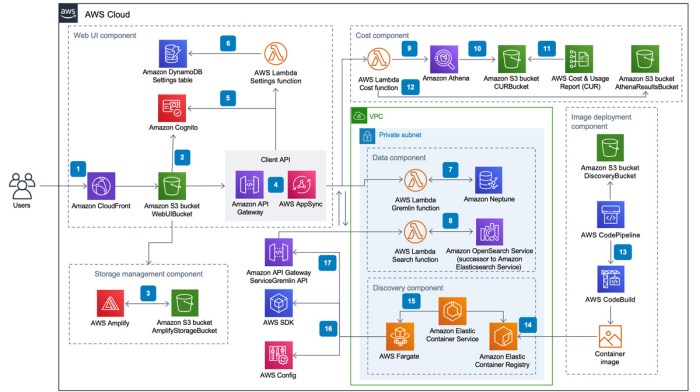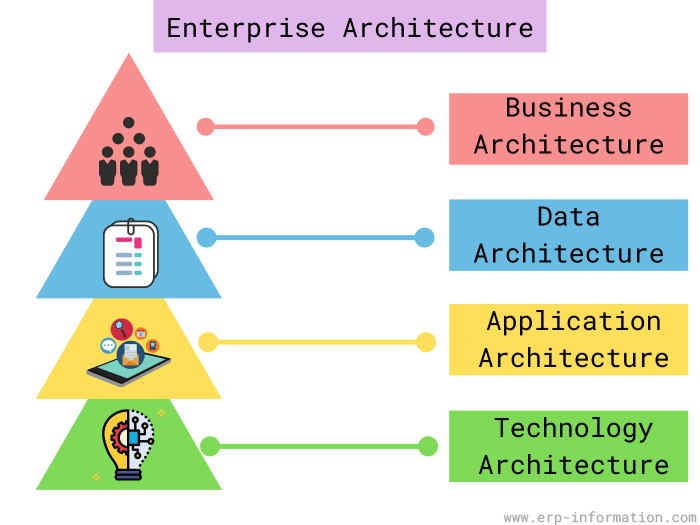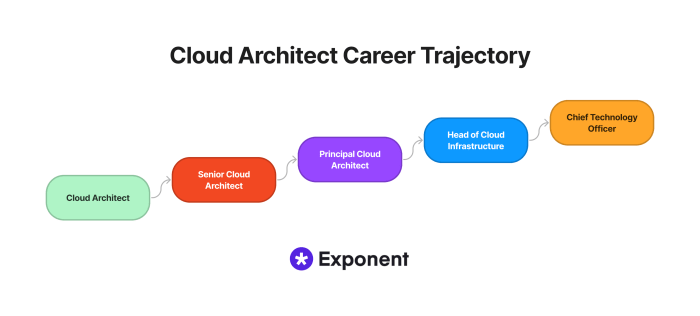The role of an enterprise architect in cloud environments is multifaceted and crucial for successful digital transformation. They bridge the gap between business needs and cloud technology, ensuring seamless integration and optimal performance. This involves a deep understanding of cloud architectures, security considerations, and cost optimization strategies.
This exploration delves into the core responsibilities, key skills, and critical considerations for enterprise architects navigating the complexities of cloud deployments. From defining cloud strategies to managing security and compliance, this comprehensive overview provides a clear understanding of this pivotal role.
Defining the Enterprise Architect Role
An enterprise architect in the cloud plays a critical role in defining and implementing the overall technology strategy for an organization. They bridge the gap between business needs and technical solutions, ensuring alignment and scalability in the cloud environment. This involves a deep understanding of both the business domain and the cloud technologies available. They are responsible for creating a cohesive and adaptable architecture that supports the company’s long-term objectives.Enterprise architects are not simply technical experts; they are strategic thinkers who can anticipate future requirements and design solutions that accommodate them.
They act as advisors and guides, working closely with various stakeholders to ensure a unified and optimized cloud deployment.
Core Responsibilities of an Enterprise Architect
Enterprise architects are responsible for numerous crucial aspects of cloud strategy and implementation. This includes defining the overall architecture, guiding the migration of existing systems to the cloud, ensuring security and compliance, and managing the ongoing evolution of the cloud infrastructure. They also play a key role in evaluating cloud providers, selecting the most suitable solutions, and establishing best practices.
Difference Between General IT Architect and Enterprise Architect in the Cloud
A general IT architect typically focuses on specific IT systems or applications within an organization. In contrast, an enterprise architect in the cloud takes a broader perspective, encompassing the entire organization’s technological landscape in a cloud environment. The enterprise architect considers the interconnectedness of various systems and applications, ensuring they work harmoniously within the cloud platform. This holistic approach is crucial for optimizing resource utilization, facilitating scalability, and maximizing the return on investment from cloud adoption.
Key Skills and Experience for a Cloud Enterprise Architect
Effective enterprise architects in a cloud environment possess a unique blend of technical proficiency and strategic vision. They require a deep understanding of cloud technologies, such as AWS, Azure, or GCP, and a strong grasp of architectural principles. Furthermore, they must be proficient in various aspects of IT infrastructure, including networking, security, and data management.
- Technical Expertise: A strong foundation in cloud platforms, networking, security, and data management is essential. This involves familiarity with different cloud services and the ability to evaluate and select appropriate solutions for specific business needs. Proficiency in various programming languages and scripting is often beneficial.
- Strategic Thinking: The ability to anticipate future needs and design scalable, adaptable, and secure cloud architectures is crucial. This includes the ability to understand business goals and translate them into actionable technical strategies.
- Communication and Collaboration Skills: Effective communication with both technical and non-technical stakeholders is vital for conveying complex information and gaining buy-in for architectural decisions. Collaboration with development teams, operations teams, and business units is a cornerstone of the role.
- Problem-solving Skills: Cloud environments often present unique challenges, demanding strong analytical and problem-solving skills to address issues efficiently and effectively. Troubleshooting complex technical problems and proposing innovative solutions is a key aspect of the role.
Organizational Structure of Cloud Enterprise Architects
Enterprise architects typically operate within a dedicated architecture team or function, often reporting to a senior IT executive or the CIO. This structure ensures that architectural decisions are aligned with overall business strategy. The team may also collaborate closely with other departments, such as development, operations, and security, to ensure smooth implementation and ongoing management of cloud infrastructure.
| Organizational Level | Typical Responsibilities |
|---|---|
| Executive Leadership | Setting strategic direction for cloud adoption and architecture |
| Architecture Team | Developing and maintaining cloud architecture standards and guidelines, providing technical guidance |
| Development Teams | Implementing cloud-based solutions based on architectural specifications |
| Operations Teams | Maintaining and supporting the deployed cloud infrastructure |
Cloud Architecture Considerations
Cloud architecture is crucial for enterprise deployments, enabling scalability, flexibility, and cost optimization. A deep understanding of architectural patterns, service models, security, and governance is essential for enterprise architects to effectively leverage the cloud’s potential. This section details key considerations for building robust and reliable cloud-based solutions.
Key Architectural Patterns in Cloud Deployments
Cloud deployments utilize various architectural patterns to address specific needs and optimize resource utilization. Understanding these patterns is vital for an enterprise architect to choose the most suitable approach. Common patterns include:
- Microservices Architecture: This pattern involves decomposing applications into small, independent services. Each service is responsible for a specific function and communicates with others via lightweight protocols. This promotes agility, scalability, and easier maintenance.
- Serverless Architecture: This model allows developers to focus on application logic without managing servers. Cloud providers handle infrastructure management, scaling resources automatically, and billing based on usage. This significantly reduces operational overhead and improves efficiency.
- Event-Driven Architecture: In this pattern, applications respond to events triggered by external or internal actions. This facilitates asynchronous communication and decoupling of components, enabling rapid response to changes and improved scalability.
- Hybrid Cloud Architecture: This approach combines on-premises infrastructure with cloud services. It provides a balance between control and flexibility, allowing enterprises to migrate workloads gradually, while retaining critical applications on-premises.
Comparison of Cloud Service Models (IaaS, PaaS, SaaS)
Different cloud service models cater to various needs and offer varying levels of control and responsibility. An enterprise architect needs to evaluate these models based on specific requirements and organizational capabilities.
| Service Model | Description | Enterprise Architect’s Perspective |
|---|---|---|
| IaaS (Infrastructure as a Service) | Provides basic computing resources like virtual machines, storage, and networking. | Offers maximum control but requires significant management overhead. Suitable for complex applications with specific infrastructure needs. |
| PaaS (Platform as a Service) | Offers a platform for developing, deploying, and managing applications without managing the underlying infrastructure. | Reduces infrastructure management tasks, allowing focus on application development. Ideal for rapid application development and deployment. |
| SaaS (Software as a Service) | Provides software applications over the internet. | Suitable for standardized applications where control is not a primary concern. Requires careful evaluation of vendor lock-in and data security. |
Security in Cloud Architecture
Security is paramount in cloud deployments. An enterprise architect must implement robust security measures to protect sensitive data and maintain compliance.
- Data Encryption: Encrypting data both in transit and at rest is critical to protect against unauthorized access. This involves using industry-standard encryption protocols and technologies.
- Access Control: Implementing strong access control mechanisms, such as role-based access control (RBAC), is crucial to restrict access to sensitive resources and limit the impact of potential breaches.
- Identity and Authentication: Securely managing user identities and authenticating users is vital. Multi-factor authentication (MFA) is often implemented for enhanced security.
Scalability and Resilience in Cloud Architecture
Cloud architectures should be designed for scalability and resilience to handle fluctuating workloads and potential disruptions.
- Scalability: Cloud platforms offer automatic scaling capabilities, allowing applications to adapt to changing demand. This ensures high availability and performance even during peak usage.
- Resilience: Redundancy and fault tolerance mechanisms are essential to maintain application availability in case of component failures. This involves replicating data and services across multiple regions.
Compliance and Governance in Cloud Architecture
Compliance and governance requirements must be integrated into cloud architecture decisions.
- Regulatory Compliance: Cloud solutions must adhere to industry-specific regulations (e.g., HIPAA, GDPR). An enterprise architect needs to ensure that the chosen cloud services and architecture align with these requirements.
- Data Governance: Clear policies and procedures are necessary for managing data access, security, and retention. This ensures that data is handled responsibly and in accordance with organizational policies and regulations.
Enterprise Architect’s Role in Cloud Strategy
The enterprise architect plays a pivotal role in shaping an organization’s cloud strategy, ensuring alignment with business goals and technical feasibility. This involves understanding the current IT infrastructure, anticipated future needs, and the potential of cloud technologies to optimize operations and enhance agility. A well-defined cloud strategy is crucial for successful cloud adoption and long-term value realization.
Developing a Cloud Strategy
A comprehensive cloud strategy begins with a thorough assessment of the organization’s current IT landscape and future objectives. This includes analyzing existing applications, data, and infrastructure to identify potential cloud candidates. Key considerations include application portability, data migration challenges, security requirements, and compliance considerations. The strategy must be aligned with the overall business strategy, considering factors such as cost optimization, scalability, and performance.
This often involves developing a phased approach to cloud adoption, starting with pilot projects and gradually expanding to broader deployments.
Migrating On-Premises Systems to the Cloud
Migrating existing on-premises systems to the cloud requires a meticulous and well-defined process. Careful planning and execution are critical to minimize disruption and ensure a smooth transition. The process typically involves:
- Assessment and Planning: Thoroughly evaluate applications, data, and infrastructure to identify potential challenges and opportunities for cloud migration. Create a detailed migration plan, outlining timelines, resources, and potential risks.
- Data Migration: Develop a robust data migration strategy, considering data volume, structure, and quality. Choose appropriate migration tools and techniques to ensure data integrity and minimize downtime.
- Application Modernization (if needed): Assess the suitability of existing applications for the cloud environment. Consider refactoring or rewriting applications to enhance performance, scalability, and security in the cloud.
- Testing and Validation: Rigorous testing and validation of migrated systems in the cloud environment are critical to ensure functionality and performance meet requirements. Establish comprehensive test plans to identify and resolve potential issues.
- Deployment and Monitoring: Carefully deploy migrated systems to the cloud environment, following established procedures. Implement robust monitoring and alerting systems to detect and address any issues.
Cloud Cost Optimization Strategies
Enterprise architects are instrumental in developing and implementing cost optimization strategies for cloud deployments. This involves understanding cloud pricing models, identifying areas for cost savings, and negotiating favorable contracts with cloud providers. Key strategies include:
- Rightsizing Resources: Optimizing resource allocation to match actual demand, avoiding overprovisioning and associated costs. Regularly review resource utilization to identify areas for improvement.
- Choosing Appropriate Services: Selecting the most cost-effective cloud services that meet specific requirements, carefully evaluating different service options to achieve the best balance between cost and performance.
- Implementing Cost Management Tools: Leveraging cloud provider tools and third-party solutions to track and monitor cloud spending. Using these tools to identify and address areas of excessive expenditure.
- Negotiating with Vendors: Negotiating favorable contracts and discounts with cloud providers based on volume, usage patterns, and specific requirements.
Vendor Selection and Management
Vendor selection is a crucial aspect of cloud deployments. Enterprise architects need to assess various providers based on their services, security, reliability, and pricing models. This involves careful evaluation of vendor capabilities, support infrastructure, and compliance measures.
- Thorough Vendor Assessment: Evaluate different cloud providers based on their strengths, weaknesses, and compliance with regulatory requirements. Consider their track record, customer support, and security measures.
- Multi-Cloud Strategy (if applicable): Explore potential benefits of using multiple cloud providers, which can enhance resilience and flexibility, potentially reducing reliance on a single vendor.
- Service Level Agreements (SLAs): Establishing clear and well-defined service level agreements (SLAs) with cloud vendors to ensure performance, availability, and security guarantees. Defining metrics for measuring and evaluating vendor performance against agreed-upon SLAs.
Defining Service Level Agreements (SLAs)
Service Level Agreements (SLAs) are essential for defining expectations and responsibilities between the organization and cloud providers. They Artikel specific performance guarantees, including uptime, response times, and support availability.
- Defining Performance Metrics: Clearly define performance metrics for cloud services, such as application availability, response time, and data transfer rates. These metrics provide a framework for measuring service quality.
- Establishing Service Level Objectives (SLOs): Translate these metrics into specific service level objectives (SLOs), defining the target performance levels for each service. Examples include 99.9% availability for critical applications.
- Artikel Dispute Resolution: Clearly Artikel the process for resolving any disputes related to service performance or adherence to the SLA.
Technologies and Tools

Enterprise architects play a crucial role in navigating the complexities of cloud deployments. A deep understanding of the available technologies and tools is essential for effectively designing, implementing, and managing cloud-based solutions. This section delves into the key cloud technologies and tools utilized by enterprise architects.Cloud technologies, such as Amazon Web Services (AWS), Microsoft Azure, and Google Cloud Platform (GCP), form the foundation of modern enterprise architectures.
These platforms offer a diverse range of services, from computing resources and storage to networking and databases, enabling architects to tailor solutions to specific business needs.
Key Cloud Technologies
Enterprise architects leverage a variety of cloud platforms. The choice depends on specific requirements and existing infrastructure. AWS, Azure, and GCP each offer unique strengths, enabling architects to select the optimal solution for a given project. For example, AWS’s extensive range of services might be preferred for large-scale deployments, while Azure’s focus on hybrid cloud solutions could be advantageous for organizations seeking to integrate on-premises and cloud resources.
Cloud Design, Modeling, and Management Tools
Enterprise architects utilize specialized tools for designing, modeling, and managing cloud infrastructure. These tools aid in visualization, automation, and orchestration, facilitating smoother deployments and improved management.
Cloud Management Platforms (CMPs)
Cloud Management Platforms (CMPs) are vital tools for enterprise architects. They provide a centralized dashboard for monitoring, managing, and automating various cloud resources. A CMP allows architects to track resource utilization, identify potential bottlenecks, and ensure compliance with established policies. Using a CMP, an architect can easily provision and de-provision resources, monitor performance metrics, and identify potential security vulnerabilities, ultimately enhancing efficiency and control over cloud deployments.
For instance, an architect might use a CMP to automate scaling resources based on demand, ensuring optimal performance and cost efficiency.
Architectural Diagrams in Cloud Deployments
Enterprise architects use various architectural diagrams to visualize and communicate cloud deployments. These diagrams provide a clear representation of the system’s components, their interactions, and their relationships. Common diagrams include:
- Deployment Diagrams: These diagrams illustrate the physical deployment of resources across different cloud platforms. They visually represent the location and configuration of virtual machines, storage, and networks, enabling architects to visualize the overall infrastructure layout.
- Architecture Diagrams: These diagrams highlight the logical design of the system, focusing on the functionalities and interactions between different components. They emphasize the system’s high-level structure and how different services work together.
- Security Diagrams: These diagrams depict the security measures implemented in the cloud environment. They highlight access controls, encryption protocols, and other security mechanisms, providing a clear overview of the security posture of the architecture.
Automation Tools in Cloud Environments
Automation tools are critical for managing and maintaining cloud infrastructure. They automate repetitive tasks, reduce errors, and enhance efficiency. Examples include tools for provisioning, configuring, and monitoring resources. An architect can leverage automation to ensure consistent deployments, optimize resource allocation, and react quickly to changing demands.For example, using tools like Terraform or CloudFormation, architects can define infrastructure as code, automating the deployment and configuration of resources.
This ensures consistency, reduces manual errors, and enables faster deployment cycles.
Cloud Security and Compliance
Ensuring the security and compliance of cloud deployments is paramount for enterprise architects. A robust security strategy is crucial to protect sensitive data, maintain regulatory adherence, and safeguard the organization’s reputation. This involves a proactive approach to identify and mitigate potential risks throughout the entire cloud lifecycle.Cloud security encompasses a wide range of practices, from implementing strong access controls to adhering to industry-standard compliance frameworks.
A well-defined security posture is not only crucial for preventing data breaches but also for building trust with customers and partners.
Security Best Practices for Cloud Environments
A comprehensive security strategy requires implementing a variety of best practices. These include robust access controls, regular security assessments, and proactive threat hunting. Regular security audits, vulnerability scanning, and penetration testing help identify and address potential weaknesses before they can be exploited.
Role of Identity and Access Management (IAM) in Cloud Security
Identity and Access Management (IAM) plays a critical role in securing cloud environments. IAM defines and controls user access to cloud resources, ensuring only authorized personnel can access sensitive data and applications. Implementing granular access controls and multi-factor authentication (MFA) enhances security and minimizes the risk of unauthorized access. Centralized IAM management simplifies administration and enables consistent enforcement of security policies across different cloud services.
Examples of Compliance Requirements for Cloud Deployments
Compliance with industry regulations is vital for cloud deployments. Examples include HIPAA for healthcare data, PCI DSS for financial institutions, and GDPR for personal data. Each framework dictates specific security controls that organizations must implement to protect sensitive data and comply with the applicable regulations. Failure to meet these requirements can lead to significant financial penalties and reputational damage.
Implementing Security Controls in a Cloud Environment
Implementing security controls in a cloud environment requires a phased approach. This involves defining clear security policies, implementing appropriate access controls, and regularly monitoring the environment for potential threats. A proactive approach that continuously assesses and updates security measures is essential for maintaining a strong security posture.
Security Risks in Cloud Deployments
Effective risk management involves identifying and understanding the potential security vulnerabilities inherent in cloud deployments. This proactive approach to security ensures organizations can minimize potential damage.
| Risk Category | Description | Mitigation Strategies |
|---|---|---|
| Misconfigurations | Improperly configured cloud resources can expose sensitive data or systems to attacks. | Automated security scans, centralized configuration management, and strict adherence to security best practices. |
| Data Breaches | Unauthorized access to sensitive data can lead to significant financial and reputational damage. | Strong access controls, data encryption, and robust security awareness training. |
| Insider Threats | Malicious or negligent actions by authorized users can compromise security. | Strict access controls, monitoring of user activity, and background checks. |
| Third-Party Risks | Security vulnerabilities in third-party services or applications used in the cloud environment can introduce risk. | Thorough vetting of third-party providers, contractual agreements, and regular security assessments. |
| Compliance Failures | Failure to comply with industry regulations can lead to legal repercussions and significant financial penalties. | Regular audits, adherence to industry standards, and proactive risk management. |
Cloud Governance and Management
Effective cloud governance is crucial for managing cloud resources efficiently and securely. It ensures alignment with business objectives, fosters compliance with regulations, and minimizes risks associated with cloud adoption. A robust governance framework empowers organizations to control cloud spending, monitor performance, and maintain consistent security postures across their cloud deployments.Cloud governance extends beyond just technical controls; it’s a holistic approach that integrates policies, processes, and people to achieve desired outcomes.
This includes establishing clear roles and responsibilities, defining appropriate security measures, and developing effective monitoring and auditing strategies.
Role of Governance in Managing Cloud Resources
Cloud governance defines the rules and policies that guide how cloud resources are deployed, used, and managed. This includes establishing clear ownership and responsibility for cloud resources, defining acceptable use policies, and implementing resource quotas and limits. Governance ensures that cloud resources are utilized in a way that aligns with business objectives and security policies. It also helps maintain consistency in cloud deployments and reduces the risk of misconfigurations or unauthorized access.
Monitoring and Auditing Cloud Deployments
Monitoring cloud deployments is essential for identifying potential issues and ensuring optimal performance. This involves continuously tracking key metrics, such as resource utilization, application performance, and security events. Auditing provides a historical record of cloud activities, enabling organizations to understand how resources were used, identify trends, and detect anomalies. Regular audits help organizations maintain compliance with regulations and policies, enabling them to identify and address potential vulnerabilities.
Examples of Metrics Used to Track Cloud Performance
Various metrics can be used to track cloud performance. Some common examples include: CPU utilization, memory consumption, network throughput, storage utilization, and application response times. Tracking these metrics allows organizations to identify bottlenecks, optimize resource allocation, and ensure optimal application performance. Real-time monitoring tools provide alerts for exceeding thresholds, enabling proactive intervention to prevent performance degradation or service disruptions.
Framework for Managing Cloud Costs
A robust framework for managing cloud costs is essential for controlling spending and ensuring budget adherence. This framework should include clear cost allocation policies, resource quotas, and detailed cost tracking mechanisms. Organizations should regularly review and analyze their cloud spending patterns, identify areas for optimization, and implement strategies to reduce unnecessary costs. Tools that provide granular cost breakdowns and predictive cost modeling can assist in identifying and mitigating potential cost overruns.
Procedure for Managing Compliance in Cloud Environments
A well-defined procedure for managing compliance in cloud environments is critical for meeting regulatory requirements and maintaining trust. This procedure should include a clear mapping of regulatory requirements to cloud controls, regular security assessments, and comprehensive compliance reporting. Establishing clear roles and responsibilities, training personnel on compliance procedures, and conducting regular audits will contribute to maintaining compliance and reducing risks.
Documentation of all compliance activities is essential for demonstrating adherence to regulations and policies.
Collaboration and Communication

Effective collaboration and communication are paramount for successful cloud adoption. Enterprise architects act as bridges between various stakeholders, ensuring alignment on objectives and fostering a shared understanding of the cloud journey. This section details the critical aspects of communication and collaboration within a cloud environment.
Importance of Communication between Enterprise Architects and Stakeholders
Clear and consistent communication is essential for successful cloud initiatives. Enterprise architects must effectively convey complex technical concepts to business stakeholders in a manner that is easily understood. Conversely, they must translate business requirements into actionable technical specifications. This two-way communication loop ensures everyone is on the same page, minimizing misunderstandings and facilitating seamless integration of the cloud solution.
Strong communication also builds trust and fosters a collaborative environment among all stakeholders.
Collaboration with Development Teams in a Cloud Environment
Development teams are crucial to the successful implementation of cloud solutions. Collaboration with them involves a shared understanding of cloud architecture principles and standards. Effective communication channels, such as regular meetings, joint design sessions, and shared documentation platforms, facilitate efficient collaboration. These methods ensure that development teams understand the technical constraints and architectural decisions, minimizing rework and potential conflicts.
Furthermore, incorporating development teams in the early stages of the cloud strategy helps in the identification of potential roadblocks and ensures solutions are built with scalability and maintainability in mind.
Communication with Business Stakeholders in Cloud Initiatives
Business stakeholders require clear and concise communication regarding the benefits, risks, and implications of cloud adoption. Enterprise architects must translate technical jargon into business-relevant language, highlighting the return on investment and strategic advantages of cloud solutions. Regular updates, presentations, and demonstrations showcasing progress are essential. These tools ensure stakeholders understand the impact of cloud initiatives on their respective departments and actively participate in the process.
Using visual aids and interactive tools can significantly improve comprehension and engagement.
Typical Stakeholders Involved in Cloud Projects
The success of a cloud project hinges on the collaboration of numerous stakeholders. These individuals represent diverse departments and functions within the organization.
| Stakeholder Group | Role in Cloud Project |
|---|---|
| Business Leaders | Define strategic direction, set priorities, and ensure alignment with overall business goals. |
| IT Operations | Ensure smooth migration, maintenance, and support of cloud services. |
| Security Teams | Assess and mitigate security risks associated with cloud adoption, ensuring compliance with regulations. |
| Development Teams | Design, develop, and maintain applications and services in the cloud environment. |
| Data Management Teams | Manage and secure data in the cloud, ensuring compliance with data governance policies. |
| Finance Teams | Evaluate costs, manage budgets, and track the financial implications of cloud adoption. |
| Legal Teams | Ensure compliance with relevant legal and regulatory requirements related to cloud services. |
Importance of Documentation for Cloud Projects
Comprehensive documentation is crucial for managing and maintaining cloud projects. From an enterprise architect’s perspective, well-documented cloud architecture provides a single source of truth for all stakeholders. This includes detailed diagrams, specifications, and procedures. Clear documentation facilitates future maintenance, troubleshooting, and scalability efforts. Furthermore, it ensures consistent implementation and reduces the likelihood of errors or conflicts.
It also serves as a training tool for new team members and a valuable reference for existing staff.
Challenges and Trends
Enterprise architects navigating the cloud face a dynamic landscape of evolving technologies and increasing complexities. Successfully deploying and managing cloud environments requires a deep understanding of the challenges inherent in this paradigm shift, along with a keen awareness of emerging trends. Continuous adaptation and a focus on future-proofing strategies are critical for long-term success.
Key Challenges in Cloud Deployments
The transition to cloud-based architectures presents several challenges. Security concerns, particularly around data protection and compliance, are paramount. Managing the complexity of heterogeneous cloud platforms and ensuring seamless integration with existing on-premises systems are significant hurdles. Cost optimization, while a key benefit of cloud, requires careful planning and monitoring to avoid unexpected expenses. Skills gaps within the organization, in both technical and architectural expertise, often impede successful cloud adoption.
Emerging Trends in Cloud Architecture
Cloud architecture is constantly evolving. Serverless computing, with its promise of reduced operational overhead, is gaining significant traction. Microservices architecture, enabling agility and scalability, continues to influence cloud design. Composable architectures, allowing for modular and adaptable solutions, are also gaining popularity. Edge computing, bringing processing power closer to the data source, is crucial for real-time applications and IoT deployments.
Multi-cloud strategies, leveraging multiple cloud providers, offer increased flexibility and resilience.
Importance of Continuous Learning and Adaptation
Cloud environments demand continuous learning and adaptation. New technologies, such as quantum computing, and advancements in artificial intelligence, are rapidly transforming the cloud landscape. Keeping abreast of these developments is essential for enterprise architects to remain relevant and effective. Staying current with best practices, security protocols, and industry standards is paramount for navigating the evolving cloud landscape.
Adaptability in response to changing business needs and technological advancements is vital for long-term success.
Comparison of Traditional and Cloud-Based Architectures
Traditional IT architectures are typically characterized by centralized infrastructure, monolithic applications, and a rigid approach to deployment. In contrast, cloud-based architectures are characterized by distributed infrastructure, microservices, and agile development methodologies. This difference impacts resource allocation, scaling capabilities, and the overall operational model. Cloud architectures offer greater flexibility and scalability compared to traditional models, which can be more rigid and costly to scale.
Future Skills for Enterprise Architects
Enterprise architects need to develop a diverse skill set to effectively navigate the cloud environment. Proficiency in cloud security, compliance, and governance is paramount. Expertise in containerization technologies, orchestration platforms, and serverless computing is highly desirable. Deep understanding of cloud cost optimization and management strategies is essential for effective resource allocation. A strong grasp of emerging trends and technologies, like AI and edge computing, is critical for future-proofing cloud architectures.
A crucial skill is strong communication and collaboration across different teams and departments.
- Cloud Security and Compliance: This includes understanding and implementing security best practices in cloud environments, staying abreast of evolving compliance regulations, and implementing appropriate security measures to protect sensitive data.
- Cloud Cost Optimization: This involves understanding and implementing strategies to optimize cloud costs, including right-sizing resources, utilizing cost-saving features, and implementing cost monitoring tools.
- Automation and DevOps: This includes using automation tools and DevOps methodologies to streamline the deployment and management of cloud applications.
Case Studies and Examples

Real-world case studies provide valuable insights into the practical application of cloud architecture principles and the role of enterprise architects in successful cloud migrations and optimizations. Understanding how other organizations have tackled challenges and achieved success is crucial for developing effective cloud strategies and mitigating potential risks.
Successful Cloud Migration Project
A major retail company successfully migrated its entire on-premises infrastructure to a hybrid cloud environment. The migration involved a phased approach, carefully planning data migration, application refactoring, and security hardening. The project was managed by a dedicated team of enterprise architects, who meticulously documented and tested each stage of the transition. This ensured minimal disruption to business operations and maximized the benefits of cloud technologies.
A key success factor was the robust communication strategy that kept stakeholders informed throughout the process. By using automation tools and establishing clear SLAs, the team managed to meet project deadlines and exceed expectations.
Cost Optimization in a Cloud Environment
A financial institution identified significant cost savings by optimizing its cloud infrastructure. This involved implementing a pay-as-you-go model for resources, leveraging serverless computing for specific applications, and implementing a comprehensive cloud cost management tool. The enterprise architect played a crucial role in analyzing resource utilization patterns and recommending appropriate adjustments to the cloud environment. By automating scaling processes, the company significantly reduced idle resource costs and improved overall cost efficiency.
The analysis identified unnecessary services and enabled the team to eliminate them.
Security Considerations in Cloud Projects
A healthcare organization implemented a comprehensive security framework for its cloud-based patient data system. This included implementing strict access controls, regular security audits, and encryption of sensitive data both in transit and at rest. The enterprise architect ensured compliance with industry regulations like HIPAA and other relevant standards. By proactively addressing potential security vulnerabilities and integrating security best practices into the cloud architecture design, the organization minimized risks and protected patient data.
The project included rigorous training programs for staff on security policies and best practices.
Addressing Challenges in Cloud Deployment
An e-commerce company faced challenges with performance issues in its cloud-based web application. The enterprise architect diagnosed the problem by analyzing application logs and performance metrics. They identified bottlenecks in the application’s architecture and implemented optimization strategies, including database tuning, caching, and load balancing solutions. This improved application responsiveness and user experience. By closely monitoring key performance indicators (KPIs) and adjusting the cloud infrastructure dynamically, the company addressed the performance issues effectively.
Table of Case Studies
| Case Study | Organization | Project Focus | Key Success Factors |
|---|---|---|---|
| Retail Cloud Migration | Major Retail Company | Complete infrastructure migration to hybrid cloud | Phased approach, robust communication, automation tools |
| Financial Cloud Optimization | Financial Institution | Cost optimization in cloud environment | Pay-as-you-go model, serverless computing, cost management tool |
| Healthcare Cloud Security | Healthcare Organization | Implementation of a comprehensive security framework | Compliance with industry regulations, proactive security measures |
| E-commerce Cloud Performance | E-commerce Company | Addressing performance issues in cloud-based application | Performance analysis, optimization strategies, dynamic adjustments |
Ending Remarks
In conclusion, enterprise architects play a vital role in driving successful cloud implementations. Their responsibilities extend from strategy development and migration to security, cost management, and collaboration with various stakeholders. By understanding the intricate interplay of cloud technologies, security, governance, and stakeholder engagement, enterprise architects enable organizations to leverage the full potential of cloud computing.
FAQ Overview
What are the key differences between an enterprise architect and a general IT architect in the cloud context?
Enterprise architects have a broader scope, focusing on aligning cloud strategies with overall business objectives. General IT architects often concentrate on specific IT systems. Cloud-specific enterprise architects must also consider security, compliance, and cost optimization within a cloud environment.
How do enterprise architects optimize cloud costs?
Enterprise architects use various strategies, including right-sizing resources, leveraging cost-effective cloud services, and implementing automated cost monitoring and control tools to optimize cloud costs.
What are some common security risks in cloud deployments?
Common cloud security risks include data breaches, unauthorized access, misconfigurations, and vulnerabilities in cloud services. Enterprise architects need to proactively address these risks through robust security policies and practices.
What are the typical organizational structures where enterprise architects operate?
Enterprise architects often work within IT departments or dedicated cloud architecture teams. Their organizational structure often reflects the company’s overall structure and cloud strategy.


